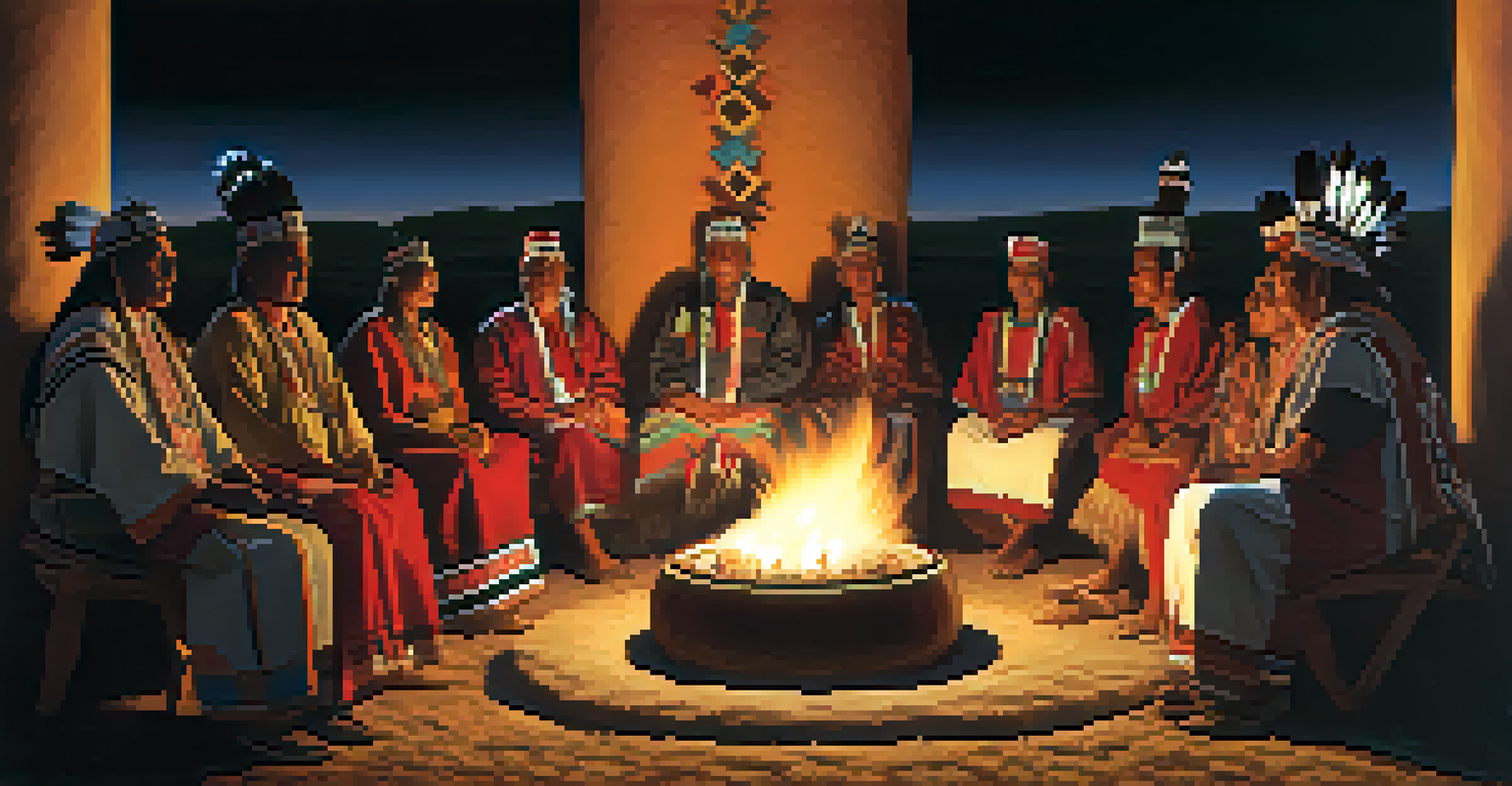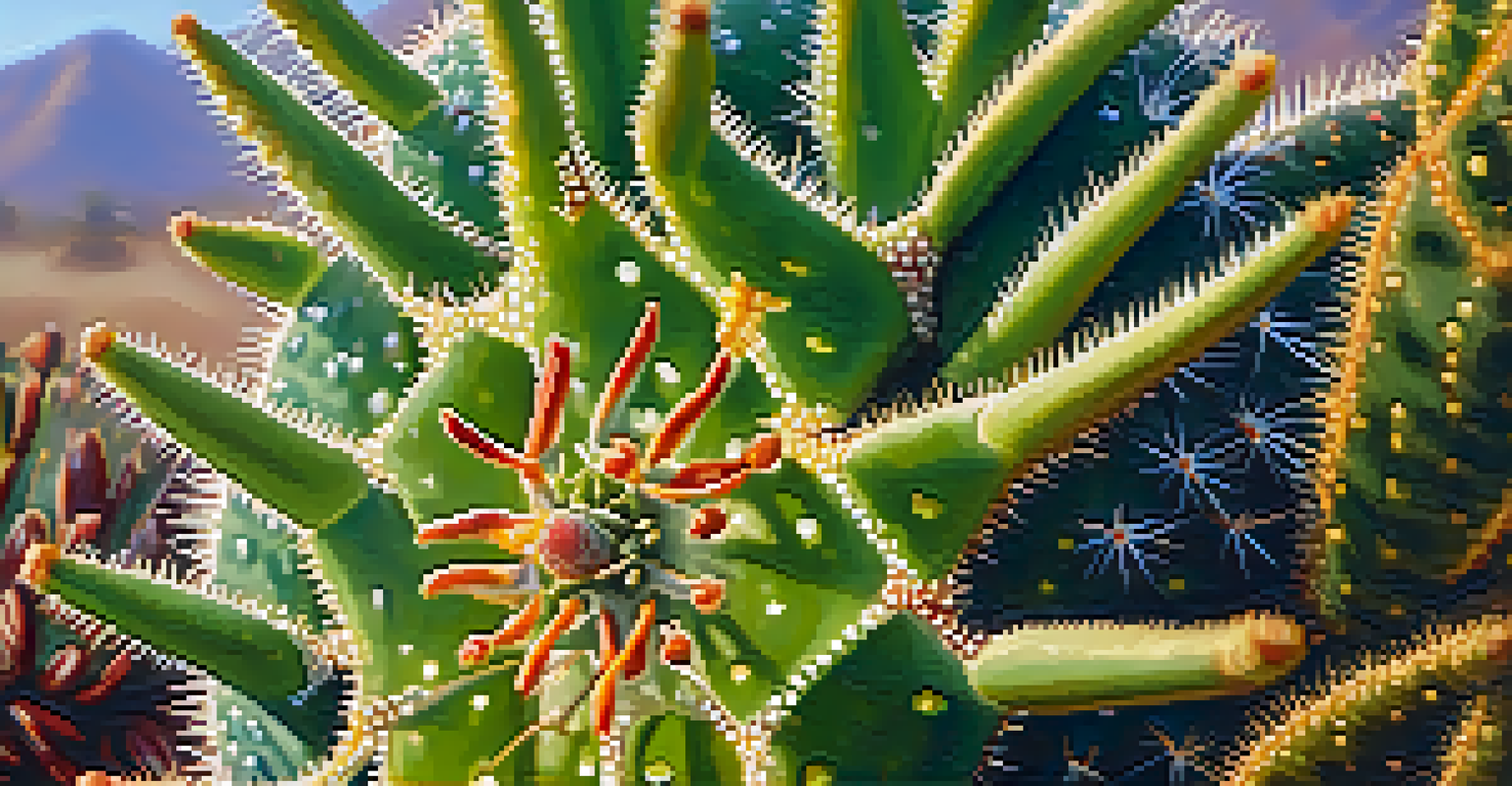Elders and the Transmission of Peyote Spiritual Knowledge

Understanding Peyote's Spiritual Significance
Peyote, a small cactus native to Mexico and the southwestern United States, holds deep spiritual significance in various Indigenous cultures. Traditionally, it’s used in ceremonies to facilitate healing, introspection, and connection to the divine. The psychoactive compound, mescaline, is what induces visions, often perceived as messages from ancestors or spiritual guides.
In every culture, there are stories, rituals, and traditions that help maintain the bond between generations and the natural world.
For many Indigenous peoples, peyote isn't just a plant; it’s a gateway to understanding the universe's mysteries. It’s intertwined with their identity and traditions, symbolizing a broader connection to nature and spirituality. This profound respect for peyote lays the foundation for its careful and sacred use during ceremonies.
The role of peyote in these spiritual practices is not only about personal experience but also about communal bonding. Elders often emphasize the importance of participating in group ceremonies, which reinforce community ties and shared beliefs. This makes peyote a spiritual bridge that connects individuals to their heritage and to one another.
The Role of Elders in Spiritual Education
Elders serve as the custodians of peyote knowledge, possessing wisdom that has been passed down through generations. They are seen as guides who help younger members navigate the complexities of peyote ceremonies, ensuring that practices are preserved accurately and respectfully. This mentorship is vital for maintaining the authenticity of these traditions.

The transmission of knowledge from elders to younger generations often occurs through storytelling, teaching the significance of rituals and the proper use of peyote. These stories carry teachings about respect for the plant, the environment, and the spiritual realm. By sharing these narratives, elders instill a sense of responsibility and reverence in the youth.
Peyote's Role in Indigenous Culture
Peyote serves as a spiritual gateway for Indigenous peoples, facilitating healing and connection to their heritage through communal ceremonies.
Moreover, the involvement of elders in these teachings fosters a strong sense of identity among younger members. It highlights the continuity of cultural practices and reinforces the idea that they are part of a larger legacy. This connection to their ancestors empowers them to uphold these traditions in the modern world.
Ceremonial Practices and Their Importance
Ceremonial practices surrounding peyote are rich and varied, often including singing, drumming, and communal feasting. These rituals create an atmosphere of unity and reverence, allowing participants to tune into the spiritual energy of the peyote. Elders play a crucial role in leading these ceremonies, often guiding the participants through each step.
The greatest gift you can give your children is not your riches, but the spirit of adventure and the knowledge of the earth.
The structure of the ceremony is meticulously planned, with each element designed to enhance the spiritual experience. Elders ensure that participants understand the significance of each aspect, helping them to cultivate a deeper connection to the ritual. This structured approach helps to maintain focus and intention during the peyote experience.
Additionally, these ceremonies serve as sacred spaces for healing and reflection. Participants often report transformative experiences that lead to personal growth and community healing. Through the guidance of elders, the collective energy of the group can amplify the spiritual effects of peyote, making the ceremonies even more powerful.
Challenges Faced by Elders Today
Despite their crucial role, elders face numerous challenges in today's fast-paced world. Rapid social changes and the encroachment of modern lifestyles can threaten the traditional ways of life in Indigenous communities. Many elders find it difficult to pass on their knowledge in environments that may not prioritize or respect these traditions.
Furthermore, the commodification of peyote and its spiritual practices presents another hurdle. As interest in peyote grows among non-Indigenous populations, there’s a risk that the sacredness of the plant could be overlooked. Elders often express concern that without proper context and respect, peyote could be misused, leading to cultural appropriation.
Elders Preserve Cultural Wisdom
Elders play a crucial role in passing down peyote knowledge and traditions to younger generations, ensuring cultural continuity and respect.
To combat these challenges, many elders are actively involved in cultural preservation efforts. They engage in education and outreach to share their knowledge with both Indigenous and non-Indigenous communities. By fostering understanding and respect for peyote and its cultural significance, they hope to ensure that future generations can continue to honor these traditions.
The Intergenerational Transmission of Wisdom
The process of passing down peyote knowledge is inherently intergenerational, creating a strong bond between elders and the youth. This transmission often occurs in informal settings, such as family gatherings or community events, where stories and teachings flow naturally. Such interactions reinforce the importance of oral tradition in preserving cultural knowledge.
Elders not only share practical knowledge about peyote but also instill values such as respect, humility, and gratitude. These teachings are essential for cultivating a responsible relationship with the plant and the spiritual practices associated with it. The youth learn to approach peyote with reverence, ensuring that they honor its power and significance.
As the younger generations absorb this wisdom, they become the next stewards of these traditions. This cyclical process helps to keep the culture alive, as each new generation brings its unique perspectives while honoring the foundational teachings of their elders. The result is a vibrant, living tradition that continues to evolve while remaining rooted in its origins.
Modern Adaptations of Peyote Practices
In recent years, there has been a subtle shift in how peyote practices are approached, particularly among younger generations. While maintaining traditional elements, some communities are incorporating modern practices to make the ceremonies more relatable. This adaptation can help bridge the gap between ancient customs and contemporary lifestyles.
For instance, some elders have begun to utilize technology to share their knowledge, hosting virtual ceremonies or discussions. This approach allows for greater accessibility, reaching individuals who may not be able to attend in person. It also fosters a sense of community among dispersed members, allowing them to connect and learn together.
Adapting Peyote Practices for Today
Younger generations are integrating modern elements into peyote ceremonies, fostering accessibility while maintaining the essence of traditional practices.
However, these adaptations must be approached with caution to ensure that the essence of the ceremonies remains intact. Elders are keen to emphasize that while innovation can be beneficial, it should not come at the expense of cultural integrity. Striking the right balance between tradition and modernity is key to preserving the spiritual significance of peyote.
The Future of Peyote Knowledge Transmission
Looking ahead, the future of peyote knowledge transmission relies heavily on the engagement of both elders and youth. It will be crucial for younger generations to actively participate in ceremonies and seek guidance from their elders. This mutual commitment will help to ensure that the spiritual significance of peyote continues to thrive.
Additionally, the establishment of educational programs focused on Indigenous spirituality can play a vital role in this transmission. By creating spaces for open dialogue and learning, these programs can foster a deeper understanding of peyote and its cultural context among both Indigenous and non-Indigenous people. Such initiatives can help bridge cultural gaps and promote respect for these traditions.

Ultimately, the transmission of peyote spiritual knowledge is a collective responsibility. By working together, communities can safeguard their heritage while also adapting to the changing world around them. In doing so, they not only honor their past but also enrich their future, ensuring that the sacred teachings of peyote remain alive for generations to come.